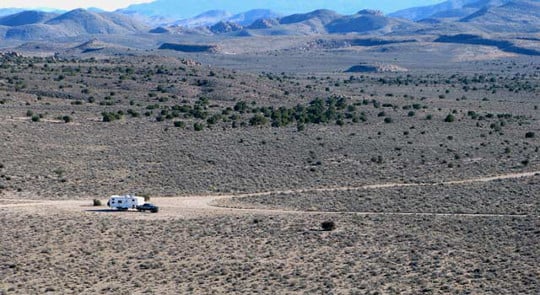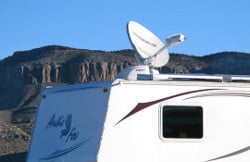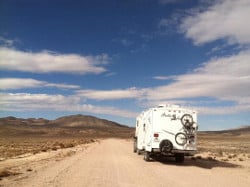Mobile Internet connectivity gives us the ability to live and work from anywhere and it’s getting better all the time. Each year a growing number of young full-timers like me are working online from our RVs and enjoying the pleasure of changing our office views whenever we want. Yet, the concept of “the untethered life” that we’re all seeking is really just an illusion for those full-timers who completely rely on cellular broadband to connect to the Internet.

Satellite Internet technology has changed dramatically in the last year. The slow speeds and agonizing latency are a thing of the past.
In reality, unless a full-timer who must be online for work invests in a satellite Internet system like the new RVDataSat 840 automatic satellite Internet antenna, their travels are limited. These Internet-based workers can only travel to areas with wireless broadband coverage if they want to earn a living. For most full-timers that’s OK, because wireless broadband coverage is better than ever.
 And as I write this from my campsite on BLM land near Quartzsite, Arizona, I would agree. I’m also enjoying Verizon’s broadband coverage – and so are thousands of other snowbirds around here, which is why my connection is hideously slow at times.
And as I write this from my campsite on BLM land near Quartzsite, Arizona, I would agree. I’m also enjoying Verizon’s broadband coverage – and so are thousands of other snowbirds around here, which is why my connection is hideously slow at times.
Thankfully I have network redundancy with my RVDataSat 840.
Mobile Satellite Internet for RVers is Better Than Ever
 Satellite Internet technology has changed dramatically in the last year. The slow speeds and agonizing latency you’ve probably heard about are a thing of the past. With the no-contract Insta-Sat service provided by Mobil Satellite Technologies, we can stream YouTube movies, upload large files faster, and use intensive apps with much better success than we ever had with our older HughesNet system.
Satellite Internet technology has changed dramatically in the last year. The slow speeds and agonizing latency you’ve probably heard about are a thing of the past. With the no-contract Insta-Sat service provided by Mobil Satellite Technologies, we can stream YouTube movies, upload large files faster, and use intensive apps with much better success than we ever had with our older HughesNet system.
MobilSat promises maximum speeds of up to 4 Mbps download and 512 Kbps upload. Look above at the speed test comparison we did one night when our new system was performing better than our Verizon Mifi wireless hotspot.
“But it’s so expensive!”
Forget the dramatic views and solitude that this technology lets you enjoy. The first question everyone asks is “What’s it cost?” Well, it starts with a $5995 equipment investment. There’s also the no-contract data service plans that aren’t cheap compared to cellular providers. But these on-demand plans let us purchase only the bandwidth we need, when we need it. For example, if we’re enjoying good urban broadband connectivity, we don’t deploy our satellite dish. But when we escape to the hinterlands, the dish goes up and we hop onto the InstaSat network portal and buy as much data as we need. When it runs out, we just purchase more.
But it’s not just for use in the boonies. We also use it in places where wireless broadband speeds are slow, like here in Quartzsite where thousands of online RVers are slowing down the local cellular service.
 The independence this allows is exciting. Yet when other full-timers learn about the price, all they can say is “But it’s so expensive!” They compare costs to the $100 wireless device that connects them to Verizon or AT&T and they can’t get past the price. That’s too bad, because they’re not seeing the value of a RVDataSat 840 system. Cost and value are two different things. To illustrate this point, consider the cost of RVs. They come in all sorts of prices and when you opt for the less expensive version, you most certainly will give up something in return. When you opt for the cheapest way to get online, you give up the freedom that comes with the true untethered life.
The independence this allows is exciting. Yet when other full-timers learn about the price, all they can say is “But it’s so expensive!” They compare costs to the $100 wireless device that connects them to Verizon or AT&T and they can’t get past the price. That’s too bad, because they’re not seeing the value of a RVDataSat 840 system. Cost and value are two different things. To illustrate this point, consider the cost of RVs. They come in all sorts of prices and when you opt for the less expensive version, you most certainly will give up something in return. When you opt for the cheapest way to get online, you give up the freedom that comes with the true untethered life.
The new RVDataSat 840 automatic satellite Internet antenna is definitely not for everyone. But if you prefer off-the-beaten-path destinations and need to be online while you’re there, it’s absolutely worth the investment. More information is available at RVDataSat.com.

Wow that’s expensive! We bought the connect a few months ago and couldn’t be happier. Never used to be close enough to the park office to get signal but now we can park about anywhere and get wifi. Still slow at some parks but much much better than it used to be. http://www.winegard.com/connect
James, what you bought has absolutely nothing to do with satellite Internet. You are comparing apples to oranges.
Why $5,000 startup? I see satellite dishes for rv around $600. Just curious what the other costs are.
It’s apples to oranges. I’m not even sure if you’re talking about satellite TV equipment. If you are, that’s a completely different setup.
Two things…
transmit capability (need to send data up, not just receive)
mobility, fancy dishes auto-locate satellite, select correct frequency, polarization while home dishes are static, set for a particular satellite illumination beamspot. Can save money with a compromise, a tripod that you setup and aim manually, for about $1500.
Finally! Some information on Sat connections! I have researched the whole gamut of cell-potential, but love the idea of a Sat connection as back-up or go-around. I am prepping to go full time, and work as an independent writer and editor, so need solid internet connections to check and respond to email daily, not weekly. I’m going with 27′ or smaller, so not looking to lumber and leave a large ‘footprint’.
Thanks for the links — a toe-hold into my research.
The Indians used smoke signals with no monthly bills. Didn’t even need a car charger. Go figure!
But it’s so expensive!